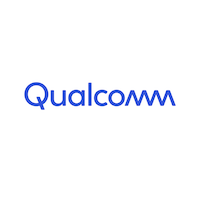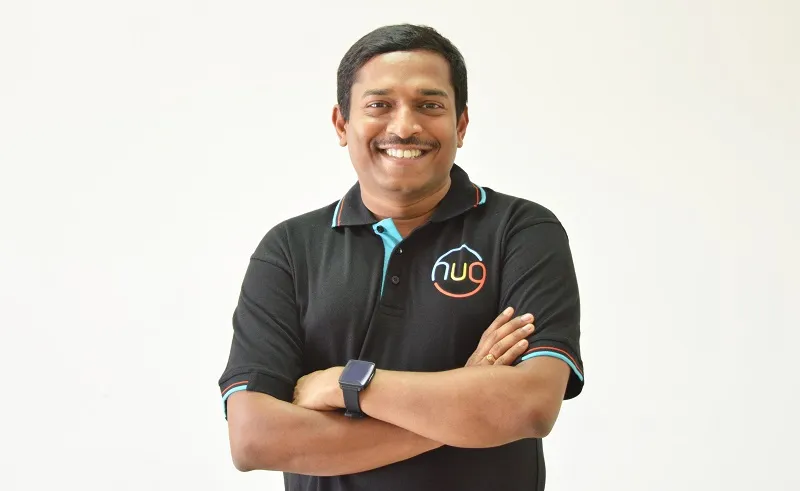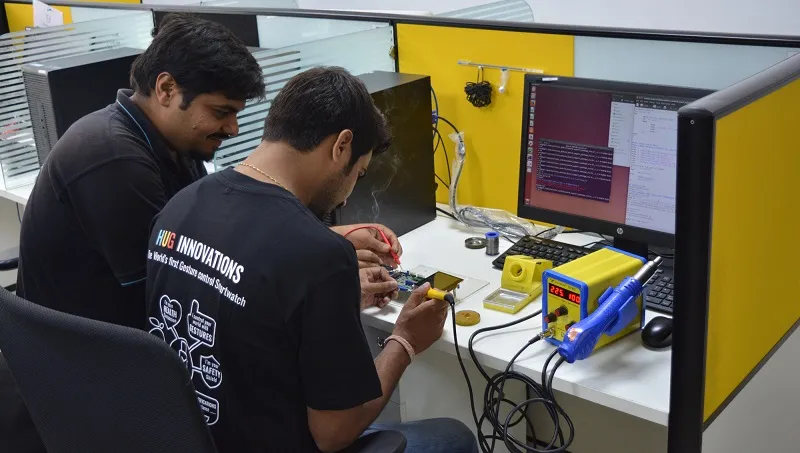
Qualcomm
View Brand PublisherA wearable HUG that can tell time, control your devices and help protect you
The debate around wearables being the future of health (as opposed to being a pricey fad) for millennials may remain inconclusive, but the numbers tell another story. In its latest report on the segment, research firm IDC has estimated that in 2017, a total of 125.5 million wearable devices will be shipped worldwide, up by 20 percent compared to last year. By 2021, that figure is expected to nearly double. Moreover, the gesture control market is projected to grow to $12.7 billion globally by 2020. Gestures are the most enhanced form of interaction using virtual reality and alternate reality technology.
In this competitive space, HUG Innovations, a Hyderabad-based startup, is trying to change the game with the world’s first gesture control smartwatch. HUG develops wearable technology solutions for gesture interactivity, healthcare, and personal safety, using customisable IoT safety platforms. The company has developed a special gesture control technology and the watch is one of the products that leverages it.
A user can wear the watch and use hand movements (gestures) to control a range of devices such as televisions, phone applications, virtual reality games or even a drone. This lightweight, multi-function watch (it weighs just 46 gm) also doubles up as an exercise monitor and can even send out SOS signals when a medical emergency occurs.
The watch works with contextual intelligence to connect with other devices such as a television, or even a drone, through Bluetooth or Wi-Fi. It has its own operating system – Nucleus – and can connect via either to your smartphone.
Raj Neravati, Founder and CEO, recalls how he started up. In 2012, he was working as COO with Cigniti in Dallas, USA, when he read about the ‘Nirbhaya’ rape case. He felt the need for a technology to promote women’s safety and launched a device called iRaksha, a personal safety band which could be activated by the press of a button, or a unique SOS trigger using a hand gesture. “Functionally, it was a good product. But we didn’t want people, especially women, to feel that if they didn’t have that device, they would not be safe. We wanted to offer more user engagement with our wearables while still retaining our safety technology,” explains Raj.

After having worked on this project for a few months on the side, he finally quit his job and founded HUG Innovations in 2015. They launched their first product – a smart watch – in 2016, with safety as a key feature in a product that people could use on a day-to-day basis.
Within a year, the startup has chalked up sales and has sold over 16,000 units of the HUG smartwatch, as well as another product that they developed for Eurokids (Eurokids Mybuddy Smart Locator). HUG Innovations recently raised $5 million in Series A funding from NRI Startup India at the second edition of the Guardian Angel Live Instant Funding conducted by TiE-Hyderabad.
The testing of the usability of gestures had its own set of challenges and learning. “In our first pilot, we had a bunch of 6-12-year-olds trying out the technology without any prior training. This exercise ran for several weeks. In each session, we strapped up the kids with our gesture control smartwatch and asked them to control a Bluetooth-enabled Lamborghini car around a track. We observed them, recorded their behaviour and then began to understand the most natural gestures we needed to build into our system,” shares Raj.
“The learnings from the pilot exercise were crucial in building the HUG gesture control technology, which can be now be used to control virtually any connected device using hand gestures. It also helped us lay the foundations for the 'HUG Gestures SDK', which allows developers to come in and build use case extensions for the future of human-machine interaction,” he adds.
In addition to wearable devices, HUG is also building a developer platform by exposing gesture technology in the form of APIs. As a result, developers can build an interactive application for IoT devices without learning any new language. This API is exposed in Java, .NET, iOS and Android.

Raj had refrained from applying to the Qualcomm India Design Challenge last year, since the HUG smartwatch was still in early development then. When entries opened again in early 2017, they were ready to compete, and in April, they were selected as one of the eight finalists for Cycle 1 of the Qualcomm Design in India Challenge 2017. Talking about the experience, Raj says, “The programme, in line with PM Modi’s Make in India vision, is a fantastic initiative for hardware startups in India. It gives them the opportunity to validate their product ideas at a world class benchmark.”
He is very happy with the fact that they are getting access to vast Qualcomm technology resources, timely support, and advice from the Qualcomm team in developing their idea successfully. Talking about their platform, Raj adds, He adds, “Our first-of-its-kind device developer platform, ‘Hug Gestures SDK’, enables the integration and extension of HUG’s proprietary gesture control technology with smart devices, mobile apps, and PC software.”
The Qualcomm IoT platform is enabling the startup to develop a much more powerful and reliable system, cut down on iterative costs, and speed up their development process. In the meantime, the smartwatch is selling online at about Rs 8,000. Currently manufactured and prototyped in Shenzhen, China, the firm is looking to manufacture the watch in India. They are currently in talks with a few state governments to figure out the location for manufacturing. The firm aims to acquire a user-base of 25,000-50,000 users by the end of this year, and reach almost a million customers in the next three years.
By the first quarter of next year, HUG Innovations also plans to start its operations in North America. They want to launch two devices next year, followed by one flagship device in the year after. They also have a kid's smartwatch with a sim slot targeting younger teens, lined up for the customers.







